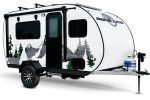Extreme Off-Road Campers
All-Terrain RVs
Extreme Off-road RVs: their most important design requirements, characteristics, features; what makes them suitable to face challenges of off-grid and out-of-civilization environment...
These days "Extreme" is probably one of the most searched words on the Internet.
This phenomenon expresses the growing trend in our society - the “Need for Adrenaline”. In the World of RV-ing it is seen as going out of beaten paths, exploring “unexplored”…
Traditionally the meaning of “Off-Road” RV-ing is rather associated with “Off-Highway” (in practice driving along gravel or dirt roads). In this article we would like to extent this notion to “No-road” or in other words “All-Terrain” (“Go-anywhere”) RV-ing. However, we wouldn’t like to promote here the “Spartan” way of exploring the Mother Nature (we leave this option for “hard-to-die” explorers). The truth is that these days it is possible to follow the love for nature, pursue dreams of “Adventure” and explore the unknown at the safety and comfort of an RV.
Below you will find the list of characteristics and features you would like to see in an RV ready to “Go-Anywhere”. And in most challenging cases “Go-Anywhere” may mean:
- Out of grid (no water & electric hook-ups)
- Out of civilization (no garage and grocery shop around the corner)
At the same time, we know that most of us do not have “endurance” of first pioneers conquering the Big West (fortunately these days there is no real need for such stamina). That is why we would like to include to this presentation of AT RVs requirements for some level of comfort if not a “touch of luxury” (whatever it means).
And all that at a reasonable price, because we believe that Extreme Off-Road RV-ing should be affordable for the large (and growing as we speak) community of Nature Lovers. In other words, our “Extreme” certainly does not mean Extravaganza!
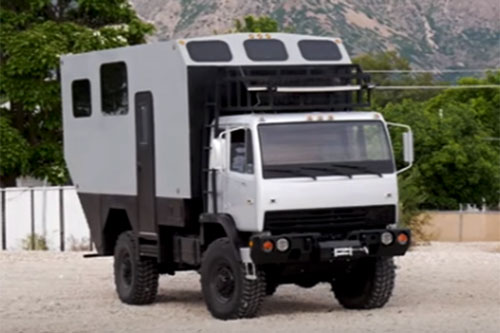
Extreme Overland 4x4 Off-Road Truck RV by ETL
1. Classes of All-Terrain RVs
We exclude big, luxurious trucks. While they are truly good off-road candidates (in fact there are many off-road truck RVs available on the market), most of them are affordable only for very limited number of RV-ers. For this reason, we limit this presentation to most popular AT RVs:
- Travel trailers
- Vans
- Tent trailers
Travel Trailers give you opportunity to use your already owned Jeep-type 4WD for whenever it can go trips (huge $$$ savings). But this is not the single advantage of travel trailers – they have more pros. For example, once you are somewhere “in the middle of nowhere”, you can leave your trailer and continue day-trip adventures exploring surrounding Mother Nature in the comfort and safety of your 4WD. Another advantage is their low profile (in other words usually better clearance when passing under the trees compared to vans).
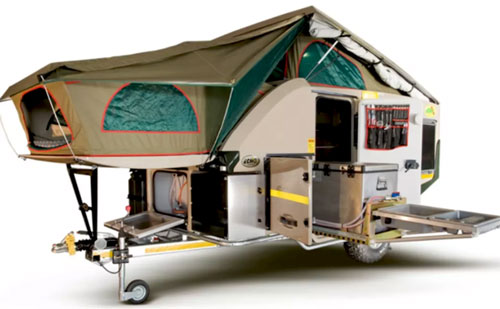
Kavango Xtreme travel trailer by Echo 4x4
Vans designed for off-road exploration are also quite popular. Their main advantage – compactness (kind of “all-in-one”). Of course, forget about nostalgic VWs as they are not designed to “go astray” from gravel roads. Unfortunately, off-road vans are more expensive and it will be hard to use them on a daily basis for commuting, so by nature it is a costly solution!
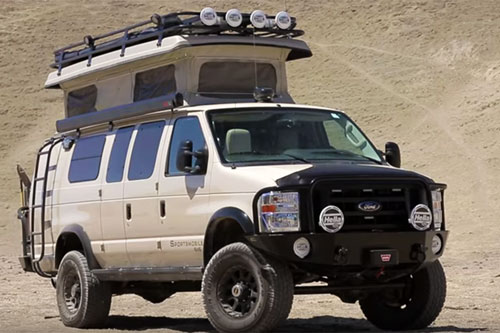
Ford 4x4 Sportsmobile van camper
Trailer Tents represent the least expensive solution for “no-man-land” adventures. Obviously, a small cargo trailer with tent on its top can easily “follow” a towing Jeep. The most practical solutions are offered as a “package” (Cargo Trailer and “designed-to-fit” on it Trailer Tent). Such “Package” will be reliable (not much can go wrong), relatively inexpensive, lite (unless you pack a lot of stuff) ... Unfortunately, Trailer Tents have limitation – most of them will not be able to offer any “taste of luxury” on your trip (it’s nice way to say that most likely you will be really “out-of-civilization” regardless where you are.
Note: To some extent Jeep-mounted Rooftop Tents can be used for off-road expeditions. In this case however you will have to give up on any "shade of luxury"....
Eezi-Awn: Glob Tracker Trailer Tent
2. Body Size
For obvious reasons exploration-grade (go-anywhere) RV-ing excludes “from the picture” big rigs. These by the nature of “physics” cannot go anywhere you want. Although there are no clear answers as of what is the magic number, the practical size (body length) of go-anywhere Extreme RV probably should be in the range from 10 ft to 15 ft. The compromise is quite clear – large enough to carry with you some “elements of civilization” like comfortable sleeping space, kitchen, supply of food, water and energy (LPG, batteries etc…), some sort of bath, camping gear, clothing, safety “package” etc…). On the other side small enough to guarantee good maneuverability, clearance, agility ….
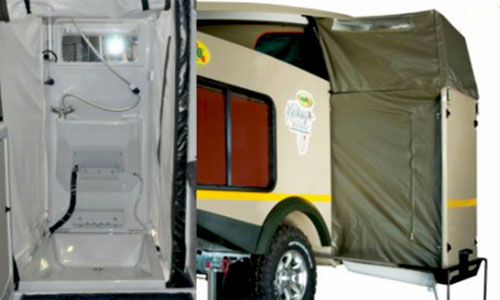
Luxury: Echo 4x4 Kavango Xtreme trailer: Slide-out shower
Left (interior), right (seen from exterior)
3. Construction
In general, Extreme Off-road RVs must be ready not only for all-terrain but also pretty-much all-weather conditions. While you may be able to avoid freezing temperatures, it wouldn’t be the case with rain, humidity (including “salty” one), scorching temperatures as well as wind, dust and eventually sand storm. In such environmental conditions shell’s (body) hermicity is of utmost importance.
Shell: Theoretically, you would like to see your Extreme Off-road RV with “single-piece”, molded-fiberglass shell. Unfortunately, while all-fiberglass (molded) shells are great for On-Road campers, they do not have good strength when it comes to mechanical impacts, strong shocks, and vibrations so frequent on all-terrain journeys. And what makes it worse, post-impact repairs of molded-fiberglass shells are complex and expensive.
That is why, overwhelming majority of AT RVs is made from combination of metal (preferably aluminum, stainless-steel), fiberglass and composite materials. Such bodies also have limitations and weak spots (rivets, bolts, nuts have tendency to loosen, glues to crack – all due to extreme mechanical stress). However, these damages are much easier and less costly to repair. May be the most difficult problem (because it is hardly visible) will be potential loss of “hermicity” leading to rain water and dust penetration.
Chassis: Aluminum due to natural resistance to corrosion (in contact with oxygen it naturally forms a thin oxide layer that prevents further oxidation) is the metal of choice at least for RV’s body. When it comes to chassis, the steel is still the preferred material due to much better mechanical properties. To prevent rusting, it has to be well protected from the direct contact with the atmosphere. Usually it is done by galvanization (preferably hot-dip for best effects) and/or powder coating. Unfortunately, such protective layers do not have “self-healing” properties (like aluminum oxide) so with time and impact of abrasive environment (gravel, stones, …) the protective layer will lose its integrity.
Important notes:
- Preferably chassis should extend over whole length of the body to minimize the extra stress induced on the shell,
- All bolts, nuts and “supporting” metal components should be made from the stainless-steel (because you cannot effectively protect them from corrosion).
- On the list of construction materials you do not want to find any form of wood, plywood, processed wood etc… Their presence is a recipe for disaster! Keep in mind that that AT RVs are subject to excessive shock, vibrations, dynamic overloads etc.. With time, these will compromise shell’s hermicity, lead to water leaks and subsequently rot and mold.
Insulation: If you plan exploring the beauty of Mother Nature in freezing temperatures, the thermal insulation is the must. Fortunately, bodies of many AT RVs (travel trailers and vans) will have some sort of insulation (layers of poly/fiberglass or foam blocks). But the problem is more complex when it comes to water pipes and tanks. Being out of grid you have limited access to electrical energy to feed thermal pads preventing freezing. Also questionable is heating given limited supply of LPG as well as the fact that most “limited-size”/Low Profile AT RVs are built as Hybrid units. In other words, some form of canvas will make part of the RV – be it rooftop tent, pop-up roof, or slide-out/fold-out tent. They do not have any insulation so the best (and only) solution will be good, winter-grade sleeping bag.
On the opposite side – cooling system in out-of-grid environment is out of question (they are too power hungry and add big pounds into the weight). Fortunately, any form of “above the ground” tent with the little help of breeze will do the job for the night.
Clearance, Approach and Departure angles - Both parameters are fundamental for off-road vehicles.
Ground Clearance – (shortest distance between the ground and the lowest point of the vehicle) is probably well understood. Higher ground clearance means better ability to pass “unscratched” over ground-level obstacles (rocks, bumps, streams…)
Approach and Departure Angles (also known as Ramp Angles) – both define maximum slopes (ramps) an RV can climb/descend without the damage (without interference with the terrain/ramp). More practical description – it’s an angle of the overhanging part of an RV in reference to front and rear wheels and horizontal line drawn at the place where wheels touch the ground. Obviously – higher value of ramp angles means better ability to explore the “Unknown”.
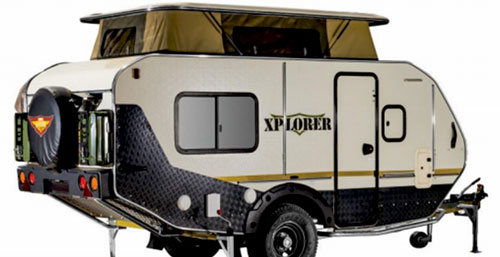
Jurgens Safari Xplorer: Note large Departure Angle
4. Weight
It’s obvious that each extra pound of AT RV weight means:
- Higher fuel consumption ($$$)
- Higher mechanical stress (dynamic load on chassis, suspension and wheels) so potential for damage or at least “weakening” of RV’s structure,
- More challenging towing efforts on steeper/rough paths (actually you may find that due to the extra weight some areas will be out of reach)
Dry Weight/GVWR ratio: While this parameter is determined by the manufacturer at the design stage (so it belongs to “Construction” characteristics (see above) we would like to make here few notes.
Obviously when planning an expedition-grade trip into wilderness you will have to carry with you a lot of extra stuff like: Food supply, Camping gear, Energy supply (LPG, batteries, solar system ….), Large amount of fresh water, Toys (kayak, bike(s)…), Basic tools and here the list will be long….
The bottom line is – you need an AT RV with good rating for cargo load and overrated (compared to GVWR) suspension able to survive dynamic loads.
5. Mechanical protection
Well-designed AT RV should have an extra protection from mechanical impacts (more or less violent “encounters” with all forms of Mother Nature, constant “bombardment” by gravel and small debris, scratching by larger stones….).
That’s why well-designed AT RVs should have:
- Bull-bars protection (bigger animals and hard obstacles we did not see)
- Diamond plate type protection (all around the shell, especially in front)
- Underbelly protection (at least stone sliders (think about crossing usually full of rocks mountain streams…).
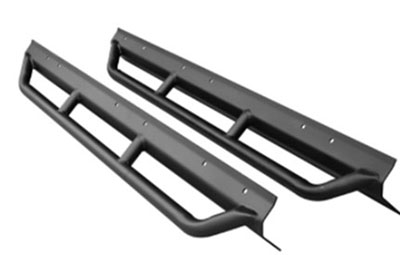
Example of Rock Sliders protecting underbelly (Land Rover accessories)
6. Reliability
Exploring “out-of-civilization” areas means also that next repair garage may be hundreds of miles away. While it will be wise to carry on expedition trips a set of basic tools and parts, the High Reliability of an AT RV is one of the most important requirements. While careful reading of manufacturer’s documents can reveal some details of design and manufacturing process as well as factory’s quality-testing process, you should (whenever possible) look on the Net for users’ reviews and feedback.
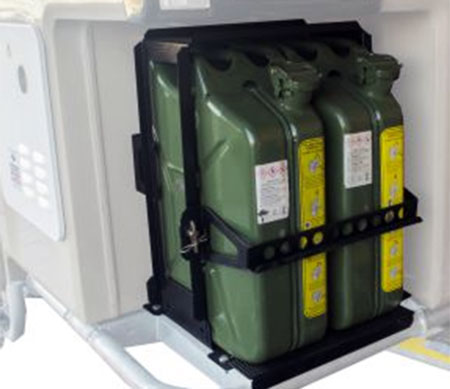
Few Jerry-Cans can be used as water or fuel tanks
7. Safety
Safety on expedition-grade trips has many dimensions. Here we will emphasize only few and these are:
Sleeping above the ground (for this reason Trailer Tents have enormous advantage over the traditional ground-based ones). While popular AT-RVs may not be serious match for big (and angry) grizzly, they should protect you from all kind of crawling beasts, small creatures and swarms if insects. While many of them will be just annoying, some may be deadly. The truth is that Mother Nature does not support “Vacuum” (Emptiness), so for sure in an out-of-civilization environment, “civilization” will be replaced by other (not necessarily friendly) forms of life. Keep in mind however, that you are “invading” their territory so show some “understanding”!
Insect screens are now the standard for most RVs (including tents)
Safety kit – It rarely will be part of standard features so make sure it is on your list
Spare wheel (does not need comments)
Run-Away brake
Alarms (Propane, CO2, smoke..) and Fire Extinguisher
And maybe not that obvious, yet very useful: Water filter. For longer “out-of-civilization” journeys you may need to use water from streams. That’s where good quality water filter may prove to be crucial.
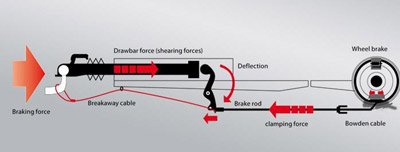
Example of the Brake-away system (here by AL-KO) that automatically activates brakes when the trailer brakes away from the towing vehicle
8. Luxury
Life is too short to give up on at least some level of luxury. So here is good news – these days many popular AT RVs (especially travel trailers) can meet most of your basic needs.
Fully equipped kitchens are typically built as exterior slide-out (or fold-out) units. They will offer all what you may need to prepare food and meals. They will include gas stove (usually 2-burner model), sink (often with running hot/cold water, fridge w/freezer, working space, pantry and storage (all accessible from exterior). You may also expect as the standard feature an ample awning covering not only the kitchen but also larger area making an outdoor “dining/living room”.
Shower: You will also find models with exterior shower (either an attached canvas cubicle or integrated “slide-out” compartment. You may also expect a Porta-Pottie with its own storage compartment and eventually interior sink faucet for private use.
Storage: Despite small size, most modern AT RVs will also offer a lot of storage space (it all depends on ingenuity of designers). Especially look for exterior storage (usually front compartment, tongue mounted boxes, jerry-cans (precious as water tanks) …..
Energy: Needless to say that in order to take full advantage of these amenities you will need energy source (LPG, DC/DC converter to charge your auxiliary batteries from the towing car (when on the road) and at least 100W of Solar Power. Please note that stove, fridge and water heater will run on gas, but you will still need electricity for lights, water pump, USB ports and eventually microwave (if any).
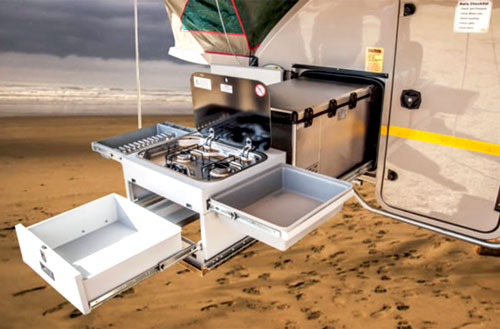
Kavango Xtreme: exterior slide-out kitchen
9. Cost
This is the most understandable and obvious parameter so just short note. We are limiting this presentation of All-Terrain RVs to models that we consider affordable, practical and as the result popular among RV-ers. There are certainly many luxurious off-road RVs, it may be even interesting to bring them to your attention, but not this time.
I hope that this introduction gave you better understanding of what you are looking for . Now it’s time to see review of popular Extreme Off-Road RVs .
Go to: --> Review of Extreme RVs
to see the presentation of best models of all-terrain/off-road RVs from all around the world. Please note that some of the best, most "matured" designs come from countries where the real "life" (bush, desserts.... instead of "tests labs" ) had the final world :-)
.


